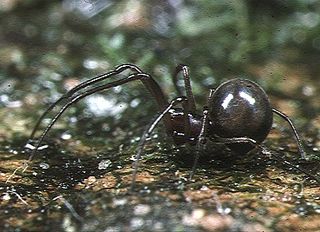
Theridiidae, also known as the tangle-web spiders, cobweb spiders and comb-footed spiders, is a large family of araneomorph spiders first described by Carl Jakob Sundevall in 1833. This diverse, globally distributed family includes over 3,000 species in 124 genera, and is the most common arthropods found in human dwellings throughout the world.

Linyphiidae is a family of very small spiders, including more than 4,300 described species in 601 genera worldwide. This makes Linyphiidae the second largest family of spiders after the Salticidae. New species are still being discovered throughout the world, and the family is poorly known. Because of the difficulty in identifying such tiny spiders, there are regular changes in taxonomy as species are combined or divided.

The ray spiders (Theridiosomatidae) is a family of spiders first described by Eugène Simon in 1881. They are most recognizable for their construction of cone-shaped webs.

Theridiosoma is a genus of ray spider. About 30 species are recognized, as of October 2015.

Pimoidae is a small family of araneomorph spiders first described by J. Wunderlich in 1986. It contains 37 species in four genera and is monophyletic. It is closely related to the Linyphiidae, and is sometimes used as a synonym for that family.

Anapidae is a family of rather small spiders with 231 described species in 58 genera. It includes the former family Micropholcommatidae as the subfamily Micropholcommatinae. Most species are less than 2 millimetres (0.079 in) long.
Synaphridae is a family of spiders with thirteen described species in three genera. It was first described as a subfamily of Anapidae, but it has since been raised to family status.

Mysmenidae is a spider family with about 135 described species in thirteen genera. The family is one of the least well known of the orb-weaving spiders because of their small size and cryptic behaviour. These spiders are found in humid habitats such as among leaf litter and in caves.

Macrothele is a genus of mygalomorph spiders in the Macrothelidae family, and was first described by A. Ausserer in 1871. It is the only genus in the family Macrothelidae, and most species occur in Asia, from India to Japan, and Java, with four found in Africa, and two in Europe. The name is derived from Ancient Greek μακρός ("makro-"), meaning "big", and θηλή ("thele"), referring to the spinnerets.
Patu is a genus of dwarf orb-weavers that was first described by Brian John Marples in 1951. Two candidates for the "smallest species of spider", are in this genus, Patu digua and Patu marplesi.
Gaiziapis is a genus of East Asian araneomorph spiders in the Anapidae family, first described by J. A. Miller, C. E. Griswold & C. M. Yin in 2009. As of April 2019 it contains only two species, both found in China.
Penangodyna is a monotypic genus of Southeast Asian cribellate araneomorph spiders in the Dictynidae family containing the single species, Penangodyna tibialis. It was first described by J. Wunderlich in 1995, and has only been found in Malaysia.
Caviphantes is a genus of dwarf spiders that was first described by R. Oi in 1960.
Erigophantes is a monotypic genus of Indonesian dwarf spiders containing the single species, Erigophantes borneoensis. It was first described by J. Wunderlich in 1995, and has only been found on Borneo.
Baalzebub is a genus of ray spiders first described by Jonathan A. Coddington in 1986.
Mosu is a genus of East Asian spurred orb-weavers first described by J. A. Miller, C. E. Griswold & C. M. Yin in 2009.












